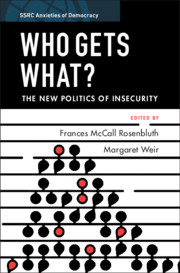Book contents
- Who Gets What?
- SSRC Anxieties of Democracy
- Sponsored by the Social Science Research Council
- Who Gets What?
- Copyright page
- Contents
- Figures
- Tables
- Author Biographies
- Acknowledgments
- 1 Introduction
- Part I People
- Part II Places
- 6 Keeping Your Enemies Close
- 7 America’s Unequal Metropolitan Geography
- 8 Redistribution and the Politics of Spatial Inequality in America
- Part III Politics
- Index
- References
8 - Redistribution and the Politics of Spatial Inequality in America
from Part II - Places
Published online by Cambridge University Press: 20 August 2021
- Who Gets What?
- SSRC Anxieties of Democracy
- Sponsored by the Social Science Research Council
- Who Gets What?
- Copyright page
- Contents
- Figures
- Tables
- Author Biographies
- Acknowledgments
- 1 Introduction
- Part I People
- Part II Places
- 6 Keeping Your Enemies Close
- 7 America’s Unequal Metropolitan Geography
- 8 Redistribution and the Politics of Spatial Inequality in America
- Part III Politics
- Index
- References
Summary
Over the past half century, the old lines between cities and suburbs have lost the significance they once had. Growing numbers of African Americans have moved to suburbs even as new cohorts of immigrants have transformed the populations of cities and suburbs. Moreover, the economic divisions of the past no longer define the geography of the metropolis: many cities have experienced economic booms and an influx of affluent residents, while poverty in the suburbs has risen. Intertwined with these spatial shifts is growing economic inequality that has richly rewarded those at the top of the income spectrum and left the middle class increasingly stressed. Place of residence presents a uniquely formidable risk in the United States. Legally sanctioned racial segregation created a template for a particularly vicious form of inequality that has endured long after formal residential segregation was outlawed. Since the 1980s, spatial inequalities have been exacerbated by the federal government’s turn away from place-based assistance. Growing economic inequality has magnified spatial differences, turning place of residence into a coveted prize -- or deep disadvantage. The profound effect of place means that understanding inequality and opportunity in America requires assessing the economic and political forces that exacerbate spatial inequalities and those that temper them. These forces and the role of the institutional structure of local government in shaping them are the subject of this chapter, focusing on segmented localism, attitudes to tax and redistribution, and the potential of a nascent progressive urbanism to reduce spatial inequality.
- Type
- Chapter
- Information
- Who Gets What?The New Politics of Insecurity, pp. 188 - 210Publisher: Cambridge University PressPrint publication year: 2021
References
- 5
- Cited by

